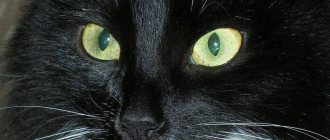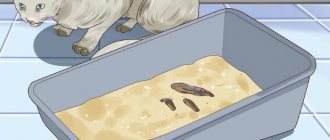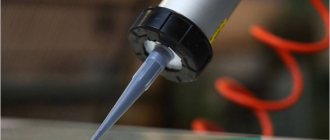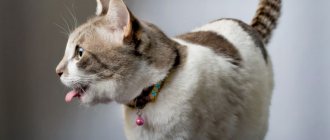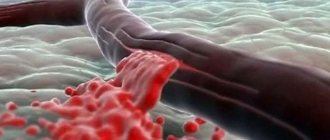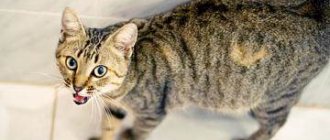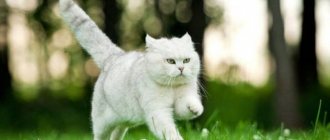The nose of any cat can tell us about the problems or health of a pet. The nose shows us what is happening to the cat at a given time. He is like a thermometer that checks the condition. The first one to take on all the symptoms of disease is the nose. In order to understand illnesses, we must know what kind of nose a healthy cat should have.
How does a cat's nose work?
As we all see, the nose is divided by cartilage into two channels. As the cat inhales air, it enters the nasal chambers. From here the air spreads through winding channels. This is where this Sami air gets trapped and the cat can smell it. From here the information goes to the brain for reading. In these channels, the smell is cleared of impurities so that the smell is clearer. By the way, in order to clear the air of dust, the sinuses heat the air to a certain temperature at which bacteria cannot survive. Air molecules react with cells that recognize odors. From here the olfactory functions come to the center.
Cats have an additional organ - Jacobson's tube. It serves as an odor analyzer that the cat can even taste. It is located above the upper sky. During the analysis, the cat takes on a slightly non-standard expression on its face.
Have you noticed that the nose is soft to the touch, like a pillow? This is the nose. He just tells cat owners that changes are happening to the body.
Diagram of the olfactory organs
The nose of a healthy cat
A healthy cat is a happy cat. Those owners who care about their pet's health often check their beloved cat's nose. But in order to correctly detect the disease, it is important to know which cat’s nose is normal and what deviations there may be.
Other cats have a dry nose as a natural breed characteristic.
Humidity and temperature
The normal temperature for a cat's nose is slightly cold and damp. It is important that the cat's nose does not exceed its body temperature. A cat's body temperature ranges from 38–39 degrees.
The moisture in the nose is maintained by special glands that help recognize odors.
The main thing is to monitor the cat’s body temperature.
Nasal discharge
A healthy cat should not have any nasal discharge. The nasal passages are clean and breathing is free. The fact that a cat's nose is wet does not refer to discharge. It is wet because a special liquid is secreted from the mucous membranes to maintain moisture, and the cat itself often licks its nose. If the nose is already excessively wet, then you can think about the cat’s ailments.
Touch the cat's nose - it should be cold and wet.
Nose color
Basically, the color of the nose will depend on the color of the cat. The nose takes on the same color as the fur near the nose.
Mostly the noses are black and pink. There are gray, purple and brown. The color should be uniform, without pigment spots that were not acquired at birth. But as they grow older, the color darkens a little. There is nothing scary about this.
But the color of the nose does not always convey the truth about the health of the cat.
Treatment
Even an experienced breeder will not be able to diagnose a dangerous disease just because the cat’s nose has become hot and dry. It is easy to make a mistake in diagnosis even based on a combination of external signs.
The main thing that the owner of a sick animal should do before contacting a veterinarian is to measure the temperature of his pet. At home, its indicator will be more accurate than in the clinic, where the cat usually experiences additional stress, aggravating the patient’s condition.
What you can handle on your own
If nothing serious has happened, the owner can bring things back to normal himself - there are a lot of similar situations, we will describe only the most common ones.
Nasal contamination
If you forget to regularly clean your pet's nose, heavy contamination will make it difficult for him to breathe and interfere with the production of physiological lubrication. As a result, thermoregulation will be disrupted and the nose will become hot. A dirty nose must be carefully cleaned both outside and inside so as not to damage sensitive tissues. After 15–20 minutes, all parameters of his condition are normalized.
Clean your cat's nose thoroughly and it will immediately feel better.
Sunburn
All cats love warmth and can happily doze off “in the sun.” But a long stay under the scorching rays of the sun will definitely not do them any good. Incidents of burns are more common than one might think, especially in animals with delicate pink noses.
A cat who has received a sunburn will have a red, hot, and sore nose. After some time, the skin on it will become rough, rough and dry. Immediately use anti-burn, moisturizing and anti-inflammatory agents - for example, Panthenol. Apply the medicine carefully so that it does not get into the nostrils, and repeat the procedure more often as the product is absorbed.
Cats with pink noses are more likely to get burned than others.
Allergy to chemicals
Many animals, like people, are prone to allergies. Remember this when cleaning your apartment - poorly washed cleansers can cause considerable harm to your inquisitive cat, who literally pokes his nose into every corner of the house.
You are cleaning with gloves, and perhaps even a respirator, but the cat’s nose is not protected by anything... Aggressive chemicals entering the respiratory system can cause severe allergies in the animal, and the nose will be the first to react: its temperature will increase, discharge or rashes will appear.
Chemicals can cause allergies in cats
It is urgent to carry out repeated wet cleaning, wash off with clean water all the remaining chemicals that provoke irritation and allergic reactions. At the same time, consult your veterinarian about which antihistamines and in what dosage should be given to your cat.
In what cases is the help of a veterinarian required?
Do not self-medicate and do not waste time; at the slightest suspicion that the animal is sick, contact a veterinary clinic. Only a doctor can conduct all the necessary studies to clarify the picture of the disease, make an accurate diagnosis and prescribe effective treatment.
A signal for an urgent visit to the veterinarian can be either the fact that the cat’s nose remains hot and dry for more than half an hour for no apparent reason, or additional alarming symptoms that were described above. Timely seeking medical help can save your pet's life - for example, in case of poisoning.
The most common condition that causes a cat's nose to become hot is rhinotracheitis, a viral infection of the upper respiratory tract. An infected cat is in a depressed state, and its nose soon becomes wet from being dry, discharge appears from it, from the eyes, from the mouth... the nose turns red, becomes covered with wounds and crusts. It is difficult for a cat to breathe and eat; the digestive and nervous systems suffer. If this disease is left untreated or treated incorrectly, the cat can suffer serious complications and even die.
Video: what to do if your cat has a cold
What kind of nose should a kitten have?
The kitten's nose will be the same as that of an adult cat - slightly cold, wet, smooth.
But in kittens, the body temperature is slightly higher than adults, so the nose will be a couple of degrees warmer than usual. This is due to the fact that heat exchange in the channels is only developing. And the color of the nose changes with age, so expect that in the future, the color of the kitten's nose will be a shade darker than it is now.
Since kittens are playful and extremely active, their nose will often be dry. Don't worry, this is a normal condition.
Kittens are more susceptible to diseases.
Action plan
If you find a dry nose in your cat, then the first thing you need to do is be patient and watch it for a day or two.
In this case, you will have the most complete picture possible, both about his behavior and regarding other possible symptoms.
If even with a dry nose, the cat’s general behavior does not change - he is very active, sleeps enough, eats well, then most likely you can dispel your worries about this.
But you must understand that even in a situation where you find a dry nose, which has begun to crack, you should not try to smear it with anything.
Getting rid of the causes of such a problem will in itself begin to return everything to normal - the cracks will heal, and the cat will lick its nose and restore the required level of humidity.
Ringworm in cats - main signs, symptoms, prevention and treatment of ringworm in cats (105 photos)Pancreatitis in cats: first symptoms, nutritional nuances and treatment options (125 photos and videos)
Subcutaneous mites in cats - first symptoms, treatment options and real photos of examples of parasite damage (110 photos + video)
Non-critical anomalies
A healthy cat may also experience changes to its nose, but this does not mean that something terrible is happening unless it is accompanied by additional symptoms.
- Dream. During deep sleep, your pet's nose warms up and becomes dry. After the pet wakes up, the nose will remain dry for some time.
- Low humidity in the room or heat. Dry air also makes your pet's nose dry. A humidifier will help cope with this.
- Activity. After playing or running around, the spout heats up.
- Stress. The pet's excitement causes fear, and fear clogs some glands, causing the nose to become dry and hot.
- Age. In older individuals, the nose no longer performs its main function, so the nose dries out.
- Nutrition. Overeating or undereating is a consequence of problems in the body; the nose becomes hot.
- Hairballs. Some cats suffer with them for a long time because they cannot empty their stomachs of them.
All these symptoms go away on their own over time. Of course, if other symptoms also appear, you should think twice and take your pet to the doctor.
Monitor your pet's condition and daily routine.
Prevention
The nose is one of those organs that undeservedly remains in the shadows when the owner examines the animal. Of course, cats are able to monitor the condition of their nose on their own and lick it when it gets dry. However, there are situations that trigger long-term inflammatory processes that the cat cannot influence. One of these situations is the already described penetration of a foreign small part into the pet’s nasal canals. Elementary carelessness of a cat can lead to painful symptoms that require serious treatment with antibiotics.
Even the owner can detect neoplasms such as polyps and quickly take appropriate measures
In this regard, a weekly nasal examination, even in the absence of cold symptoms, will be an excellent way to prevent respiratory diseases. Periodic examinations and palpating of your pet’s nose can protect him from advanced illnesses. You can check your pet's nose by touching it with the back of your hand.
All manipulations carried out with the cat must be done with clean hands.
Try to perform home diagnostics under sterile conditions. Wash your hands before palpating, even if you are sure they are clean. The possibility of infection due to negligence also exists on the part of the owner.
In addition to diagnostics, it is acceptable to clean your cat’s nose from time to time. If you are ready to deal with your pet's protest and calm him throughout the procedure, then the tips presented below will help you make the cleansing process easier.
How to clean a cat's nose
Reason to worry
If you notice any ailments, check the symptoms.
- If a cat begins to frequently wash its face with its paws, rubs its nose and eyes, and discharge occurs, there are clear signs of an allergy.
- Ulcers, spots, and crusts appeared on the nose - signs of dermatological diseases.
- Sneezing and a wet, dry nose indicate a cold.
- Hot ears and lips, as well as the color of the nose indicate an increase in temperature. A blue nose indicates hypothermia. Severe pallor indicates anemia and dehydration. Red nose - oxygen starvation, allergies or rhinitis.
- Vomiting and diarrhea indicate a more serious illness - poisoning.
- Apathy, loss of appetite, sleep disturbance indicate the presence of a disease.
First, you should measure the cat's body temperature, but not everyone has a special thermometer for animals, and not everyone is able to measure the temperature. Therefore, when various symptoms appear, veterinarian intervention is required.
The doctor can find possible causes of diseases based on symptoms. Commonly encountered diseases include:
- Rhinitis is a cold.
- Sinusitis.
- Allergic reactions.
- Infections.
- Worms.
- Injuries to the nasal canals and palate.
Also, after castration or sterilization, the pet’s nose may become hot during the day. This reaction is normal, because drugs that are administered to animals as anesthesia block the glands that regulate nasal circulation. In order not to panic, monitor your pet for 24 hours. If the situation does not improve after a couple of days, you should think about it.
Pay attention to the nose and the fur around it.
What to pay attention to
If the nose remains dry for a long time, this is usually a sign of the development of the disease, while a hot nose is a sign of increased body temperature. Not only the temperature and humidity of the olfactory organ can indicate health problems. A change in its color can also be a sign of a cat’s disease:
- lightening - typical in case of disturbances in the functioning of the circulatory system, hypothermia, poisoning;
- turning blue indicates a lack of oxygen or cardiovascular disease;
- yellowing - appears with kidney or liver diseases;
- redness - develops with damage, increased temperature or pressure, various types of infections (runny nose, sinusitis) and allergic reactions.
In this matter, not everything is so simple, because the change in color is influenced by the surrounding temperature, as well as the color and breed of the pet: for some, the nose darkens in the cold, for others, on the contrary, it becomes slightly lighter. To determine your health status, the presence of other symptoms should also be taken into account. For example, if a cat refuses food and water, becomes lethargic and inactive, vomiting or upset stool appears - these are clear indications for consulting a veterinarian, who will be able to determine the causes of this phenomenon and provide the necessary assistance.
How to examine a cat's nasal cavity
This is done exclusively by a veterinarian who uses special testing tools. The examination is carried out only under anesthesia so that the cat does not feel pain or discomfort.
Also, to measure temperature, the doctor inserts a thermometer into the anus - this is how the pet’s body temperature is measured.
The doctor will carry out procedures, identify important deviations and prescribe the correct treatment. Some procedures will have to be carried out exclusively with a doctor, some the veterinarian will show you, and you will treat the cat at home.
The help of a doctor will never hurt, because he will correctly diagnose and prescribe the right medications.
